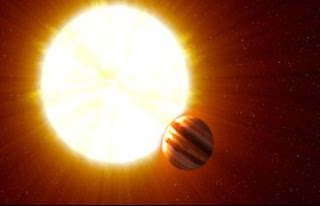Astronomers have found a planet with clouds of sand
Astronomers around the world today are actively studying the planet outside the solar system, but the latest find is noticeably surprised experts. Three independent teams of astronomers using the Spitzer Space Telescope have learned two gaseous planet in the constellation Pegasus and Fox. For its size planets are comparable to the largest planet of the solar system - Jupiter. According to the initial assumption of experts on both planets was supposed to attend the water, at least in the form of vapor in the atmosphere, but subsequent observations showed erroneous data guesswork. According to some data, the atmosphere of these planets is made of tiny sand grains, called silicates.
These silicates are located in the atmosphere in such a way that they are formed from clouds of. According to astronomers, scientists still have not been able to detect planets, clouds which would consist in the direct sense of the sand. According to Karl Grilmeera, an astronomer at Caltech, data Though the planet is a gas giant, their structure and characteristics are fundamentally different from that with which previously had to deal with. Most likely, concludes Grilmeer, strange planets data on sand clouds do not stop there. From a technical point of view, the two planets are located quite close to the stars (10 times closer than Jupiter is from the Sun), so the temperature on the surface to be quite high - about 800 degrees. Experts believe that these planets may exist some primitive life forms that feed by analogy with terrestrial plants, living off oxygen and sunlight.
"In theory, these planets may contain oxygen and water in the form of steam, compressed under pressure. And possibly life. fact that planet this kind, also called "hot Jupiter" was formed of the same material as the star - of hydrogen. During formation planet it could be oxygen and in small quantities, and given nuclear reaction of a lot of pressure in the bowels of the planet, then there could be water and, as a result of nuclear fusion of hydrogen and oxygen, "- says Grilmeer.
According to other astronomers who observed the data of the planet, there may be water lies under a thick layer of silicate clouds. In addition, there is the possibility that there are present and methane with carbon dioxide, although so far they have not been found. planets discovered in the constellation of the Fox received a number of HD 189733b. Its distance to the Earth at 62 light years, and the period of rotation of the star is 2.2 Earth days. Planet found in the constellation Pegasus, HD 209458b has been numbered and is located in 153 light-years from Earth, and the period of its circulation is 3.5 Earth days.



.jpg)

